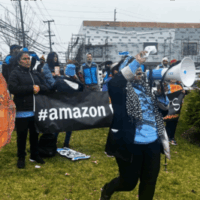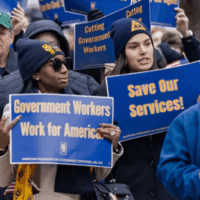Center for American Progress, Georgetown Center on Poverty and Inequality, and National Employment Law Project release report on updating unemployment insurance for a 21st century economy and establishing a new Jobseeker’s Allowance.
Washington, D.C. — Today, three leading organizations dedicated to bolstering economic security and opportunity released a set of new proposals to strengthen unemployment protections for America’s working families. The Center for American Progress, the Georgetown Center on Poverty and Inequality, and the National Employment Law Project introduced a comprehensive package of reforms to modernize the unemployment insurance, or UI, system. These reforms would enhance worker mobility, reduce unemployment, protect independent contractors for the first time, and better prepare the economy to withstand unexpected downturns.
UI was a vital tool for both family economic security and national economic stability during the Great Recession and continues to help working families get back on their feet, largely due to significant but temporary improvements in the past seven years. However, the United States has severely underinvested in UI and the system and has not kept pace with changes in the labor force or the economy. With more than two-thirds of Americans experiencing at least a year of unemployment for themselves or their head of household during their working years and the inevitability of another recession, there is no better time to update this crucial part of the social insurance system. The proposed reforms would modernize UI into a more robust employment, training, and income-security system for involuntarily unemployed workers and prepare the system’s finances for the next recession.
In addition to the proposed UI reforms, CAP, GCPI, and NELP offer new ideas—including the establishment of a modest short-term benefit called the Jobseeker’s Allowance, or JSA—to help address the remaining shortcomings of the current system. By extending protection to workers who remain ineligible for UI—including independent contractors, so-called gig economy workers, and young people transitioning from school to work—the JSA would increase workforce participation and further boost economic security.
Together, these reforms would increase the share of jobless workers protected by unemployment protections to more than three in four—compared to only approximately one in four unemployed workers receiving UI today.
“As the nature of work has changed, the UI system has not kept up, leaving more and more workers vulnerable to hardship if they are laid off,” said Melissa Boteach, Vice President of the Poverty to Prosperity Program at CAP. “Even if the country is fortunate to continue our current economic expansion for an unprecedented period, now is the time to modernize outdated policies before another recession hits, for the sake of both working families and the economy at large.”
“We are at a historic low in terms of jobless workers having access to unemployment protections—only about one in four jobless workers receives UI benefits today,” said Indivar Dutta-Gupta, Director of the Project on Deep Poverty at GCPI. “The failure to modernize our UI system hurts us all but has a disproportionately negative effect on women, low-paid workers, younger workers, and workers of color.”
“State decisions to weaken their UI programs in recent years have underscored the need for a stronger federal role in this federal-state partnership, by mandating the most critical reforms,” said Claire McKenna, Senior Policy Analyst at NELP. “This proposal would guarantee a minimum level of benefit protection across states during this most critical of periods in a person’s life—unemployment—and ensure that states are building up reserves during good economic times to sustain their workforces when conditions turn.”
Recommendations to Modernize UI:
A modernized UI system would help involuntarily unemployed workers actively seek employment, connect to job opportunities, and improve their work-related skills. The report proposes detailed reforms to expand UI eligibility to reach more unemployed workers, improve the adequacy of UI benefits, and increase participation in the program. It also recommends reforms to UI financing that would improve the program’s solvency and lays out steps that would improve its ability to respond to future recessions—including repairing UI’s Extended Benefits program.
Creating a Jobseeker’s Allowance:
The proposed JSA is a moderate, short-term benefit for jobseekers who would not qualify for UI, such as independent contractors, caregivers returning to the labor market, and workers with limited job history. In addition to serving as a lifeline while individuals search for work, the JSA would increase labor force participation and help stabilize the U.S. economy. Through JSA, workers in the so-called gig economy and other independent contractors would be eligible for unemployment protection for the first time ever.
The report also includes estimates based on updated, independent analysis from the Urban Institute—commissioned by CAP, GCPI, and NELP—which shows that just three of the proposed reforms would significantly increase the share of newly unemployed workers who are protected by UI. These reforms alone would boost the share of workers who are able to rely on UI when they become newly unemployed by nearly 9 percentage points (from 64.7 percent to 73.6 percent)—an increase of more than 13 percent.
Read the full report and fact sheet online here: “Strengthening Unemployment Protections in America” by Rachel West, Indivar Dutta-Gupta, Kali Grant, Melissa Boteach, Claire McKenna, and Judy Conti.
Key Facts and Figures:
- UI has been a pillar of the nation’s social insurance system for 80 years.
- During the Great Recession, UI closed nearly one-fifth of the shortfall in gross domestic product.
- In 2009 alone, UI kept more than 5 million Americans out of poverty and saved more than 2 million jobs by boosting demand.
- Between 2008 and 2012, UI prevented an estimated 1.4 million foreclosures.
- Only one in four unemployed workers—27 percent—received UI in 2015, down 8 percentage points in the last decade.
- Thirteen states compensate less than one in five jobless workers.
- More than two-thirds of American households experience at least a year of unemployment during their working years.
Related Resources:
- Fact Sheet: A Plan to Improve Unemployment Protections in America
- A Progressive Agenda to Cut Poverty and Expand Opportunity by Melissa Boteach, Rebecca Vallas, and Eliza Schultz
- New Census Data Demand Action on Inequality and Poverty by Melissa Boteach (TalkPoverty.org)
- Lessons Learned from 40 Years of Subsidized Employment Programs by Indivar Dutta-Gupta, Kali Grant, Matthew Eckel, and Peter Edelman (GCPI)
- Poverty and Inequality in America: Why We Should Care and What We Should Do by Indivar Dutta-Gupta and Kali Grant (GCPI)
- The Job Ahead: Advancing Opportunity for Unemployed Workers by Claire McKenna (NELP)
- Unemployment Insurance Policy Advocate’s Toolkit by Rick McHugh, Rebecca Dixon, Claire McKenna, and George Wentworth (NELP)
###
Related to
The Latest News
All newsMayor Bowser and D.C. Council Must Recognize Will of D.C. Voters by Rejecting Repeal of Initiative 82

Blog
New Brief Sheds Light on the Amazon’s Dangerous ‘Flex’ Labor Model

News Release
NELP Denounces Supreme Court Ruling Permitting Immediate Layoffs of Hundreds of Thousands of Federal Workers

News Release
